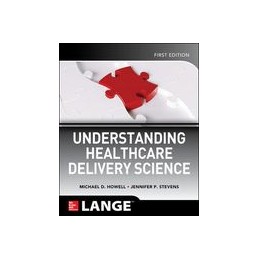


 Dostawa
Dostawa
Wybierz Paczkomat Inpost, Orlen Paczkę, DPD lub Pocztę Polską. Kliknij po więcej szczegółów
 Płatność
Płatność
Zapłać szybkim przelewem, kartą płatniczą lub za pobraniem. Kliknij po więcej szczegółów
 Zwroty
Zwroty
Jeżeli jesteś konsumentem możesz zwrócić towar w ciągu 14 dni. Kliknij po więcej szczegółów
Opis
PART I: WHAT IS HEALTHCARE DELIVERY SCIENCE, AND WHY DO WE NEED IT?
Chapter 1
Introduction
The Problem: How Research and Operations Are Organized in Healthcare Today
Historical Context: How Did It Get This Way?
Why Now Is Different: Two Key Changes in Context
Why It Matters: Problems with Thinking Too Simply About Healthcare
Healthcare Delivery Science
References
Chapter 2
Complexity
What Happens When We View Healthcare as Complicated?
What Is a Complex Adaptive System?
Why It Matters: Fitting the Right Measurement Tool to the Question
Healthcare Delivery Science: A Field of Research Where Healthcare Itself Is the Organism Under Study
References
Chapter 3
Quality and Safety in Healthcare
The Best the World Has Ever Seen
Three Critical Papers to Know
An Inflection Point: To Err Is Human and Crossing the Quality Chasm
More Recent Estimates About Deaths from Medical Error
International Comparisons
Have Improvement Efforts Worked?
How We Put It All Together
References
Chapter 4
What Does the Future Hold?
Introduction
Value Drives Change
The “Postsafety” Era
Healthcare Delivery That Delivers Health
Consumerism Versus Personalization
The Doctor Will See You Now?
Informed Healthcare Information Technology (IT)
Conclusions
References
PART II: MAKING CHANGE IN THE REAL WORLD—TOOLS FOR HEALTHCARE IMPROVEMENT
Chapter 5
Human Factors
Human Factors: An Introduction
Cognitive Reasoning, Errors, and Biases in Healthcare
Hierarchy: What Is It, How Do We Measure It, and Why Does It Matter?
Tools for Understanding Complex Systems
Conclusions
References
Chapter 6
How Teams Work
Types of Teams
What Do Teams Need to Succeed?
Poorly Functioning Teams in Healthcare
Teams in Aviation and the Birth of Crew Resource Management (CRM)
CRM in Healthcare
Leading Teams Through Change
References
Chapter 7
Leadership and Culture Change
Leading Change Is Difficult
Where to Start
What Is Implementation Science?
Implementation Science Frameworks
Integrating Implementation Science Frameworks for the Purpose of Change Management
References
Chapter 8
Standard Quality Improvement Tools and Techniques
Introduction
Preventing Adverse Events and Improving Patient Safety
Identifying Patient Safety Events
Root Cause Analysis (RCA)
Failure Mode Effects (and Criticality) Analysis (FMEA and FMECA)
Safety I and Safety II
Process Improvement and Quality Improvement
References
Chapter 9
Lean Improvement Techniques in Healthcare
A Brief History of Lean
The Rules of Lean
A Concrete Definition of the Ideal
The 8 Wastes
Tools from Lean
Summary
References
Chapter 10
Partnering with Community, Professional, and Policy Organizations
Introduction
How Health Is Created
Key Stakeholders in Shaping Health
Engaging with Local Public Health Agencies
Approaches to Successful Partnerships
Concluding Thoughts
Acknowledgments
References
PART III: SEEING THE TRUTH—ANALYTICS IN HEALTHCARE
Chapter 11
Data in Healthcare
Part 1: Fundamental Issues in Healthcare Data
Part 2: The Importance of Understanding Data Lineage, and How This Leads Mature Organizations to Both Informal and Formal Data Governance
Part 3: Basic Understanding of Relational Database Structures
Part 4: Review of Common Approaches to Actually Accessing Healthcare Data
Conclusion
References
Chapter 12
Measuring Quality and Safety
Quality Measurement Frameworks
What Are You Trying to Achieve? Improvement, Comparison, or Accountability
What Makes a Good Measure?
Challenges
Common Measure Sets and Major Pay-For-Performance Programs
References
Chapter 13
Overview of Analytic Techniques and Common Pitfalls
Dinosaur Footprints and What They Tell Us About Data Analysis in Healthcare
The Four Horsemen of Mistaken Conclusions
The Critical Importance of Missing Data
The Shape of Data: Categories of Data and Why They Matter
Overview of Analytic Methods
References
Chapter 14
Everyday Analytics
Summarizing Your Data
Displaying Data
Outcomes Over Time, Part I – Run Charts
How to Tell if Two Groups Are Different: Univariable Tests of Difference and Measures of Comparison
Outcomes Over Time, Part 2—Statistical Process Control (SPC) Charts
Everyday Analytics
References
Chapter 15
Survey-Based Data
Introduction
Perhaps the Most Important Thing Youll Learn in This Chapter
What Are Some of the Main Purposes of Surveys?
Overview of Conducting a Survey
Some Pitfalls
References
Chapter 16
Predictive Modeling 1.0 and 2.0
What to Expect in This Chapter
Predictive Modeling 1.0
Predictive Modeling 2.0
Taking Predictions to the Next Level
References
Chapter 17
Predictive Modeling 3.0: Machine Learning
Definitions: What Is Artificial Intelligence? Machine Learning?
A Brief History of Artificial Intelligence
Translating Epidemiology to Machine Learning
Categories of Machine Learning Used in Healthcare
Pitfalls in Using Machine Learning in Healthcare
The Future
References
Chapter 18
What Everyone Should Know About Risk Adjustment
What Is Risk Adjustment, and Why We Should Care?
What Risk Adjustments Are Available, and How Should We Assess Them?
Examples of Risk Adjustment Gone Awry
Using Risk Adjustment in Local Healthcare Delivery Science
References
Chapter 19
Modeling Patient Flow: Understanding Throughput and Census
Why Does Understanding Patient Flow Matter?
Understanding Patient Flow Conceptually
Analytical Approaches to Understanding Patient Flow
Summary
References
Chapter 20
Program Evaluation
Causal Methods
Quasi-Experimental Designs—Causal Inference in Observational Data
Evaluations in the Real World
References
Chapter 21
How to Embed Healthcare Delivery Science Into Your Health System
Introduction
How Do I Join (or Build) a Community of Healthcare Delivery Science?
How to Embed Healthcare Delivery Science in Your Health System
Summary
Reference
Index
